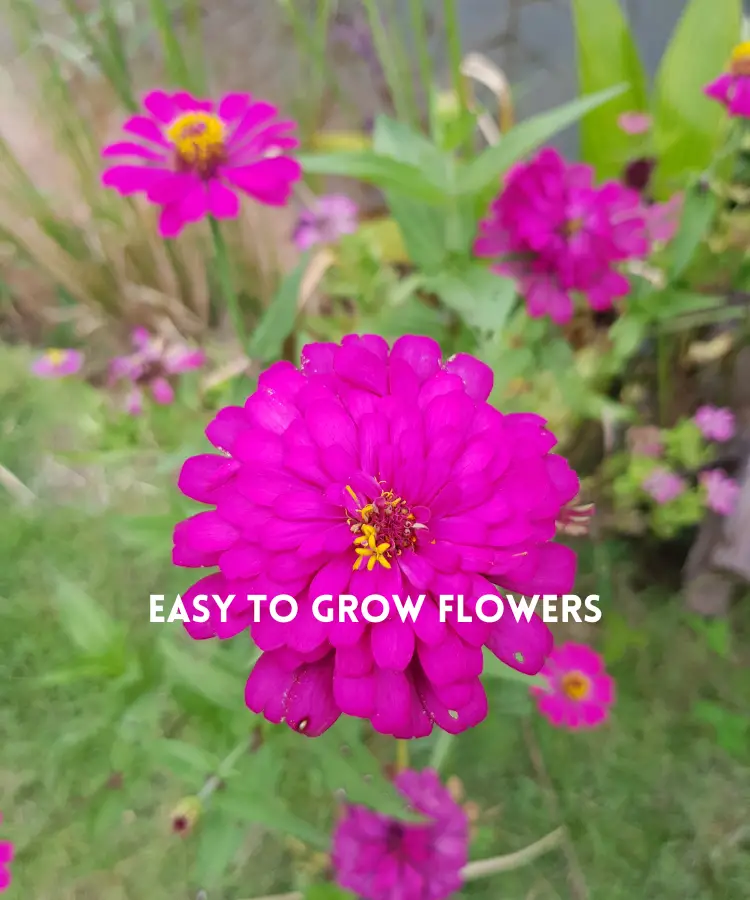Having fresh flowers around the house or in your garden just brightens everything up. There’s nothing quite like the pop of color and natural beauty that flowers provide.
But if you’re new to gardening, growing flowers from seeds or bulbs can seem intimidating.
No need to worry!
There are plenty of easy-to-grow annual and perennial flowers that are perfect for beginners.
The greatest minimal-maintenance flower selections to get you started will be covered in this book, along with advice on planting and caring for them. With little work on your part, you will soon have a flourishing flower garden.
Top 5 Easy Annual Flowers for Beginners
Annuals are flowers that complete their life cycle in just one growing season. They go from seed to bloom to seed in a single year before dying off. Since they’re fast-growing, annuals are great for getting color quickly. They allow you to switch up your flower bed designs each year, too. Here are five of the easiest annual varieties to grow:
1. Sunflowers
These bright, cheery flowers are sure to bring a smile to your face every time you see them.
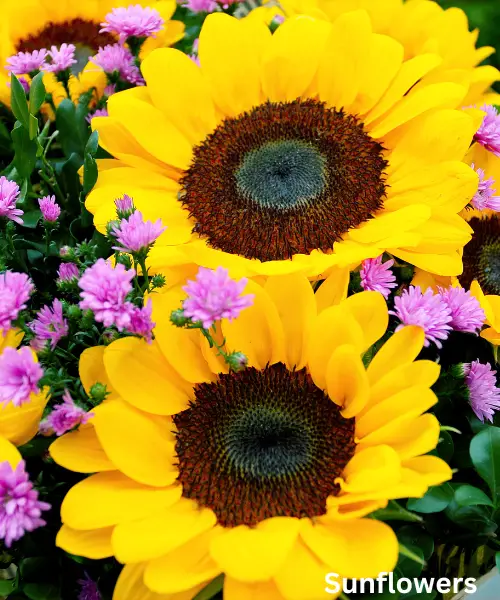
Sunflowers are incredibly easy to grow from seed directly sown into the ground once the danger of frost has passed in late spring. They’ll shoot up rapidly during warm summer months, some varieties reaching over 6 feet tall!
For best results, plant sunflower seeds around 1 inch deep and 6 inches apart in an area with full sun exposure. The seeds will germinate in 7–10 days.
Keep the soil moist until the seedlings are 4-6 inches tall, then you can ease up on watering a bit. Stake tall varieties once they’re a few feet high to prevent them from falling over. Sunflowers make great cut flowers that last up to 10 days in a vase when cut in the morning.
Leave some blooms on the plant to develop seeds you can roast and snack on too. Try planting new seeds every 2-3 weeks for non-stop sunflowers all season!
2. Zinnias
With bright colors spanning nearly every shade, zinnias definitely won’t get lost in your flower bed! These are one of the simplest flowers to grow, bouncing back with new blooms even after severe pruning. They make for fantastic cut flowers as well.
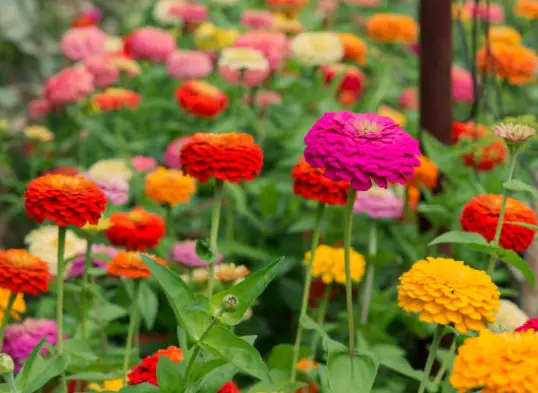
Zinnias come in dwarf varieties as short as 6 inches tall, as well as towering 4-foot giants.
Sow zinnia seeds directly in the ground once temperatures remain above 50°F at night. Plant in full sun, spacing about 6–12 inches apart.
The seeds will sprout within a week. Once plants are established, make sure to water deeply, about once or twice per week. Removing wilted blooms (deadheading) will encourage lush new flower production all season.
Zinnias thrive in hot summer conditions, continuing to bloom until the first hard freeze.
3. Marigolds
With their distinct, pungent scent and vibrant, warm colors, marigolds are a gardening classic. But these aren’t just pretty flowers—they are workhorses in the garden too! Marigolds are excellent for natural pest control, deterring nematodes and other pests while attracting beneficial insects.
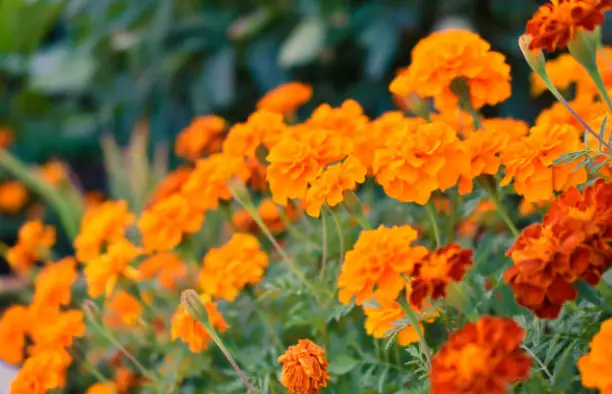
Marigolds germinate rapidly in as little as 5 days when sown directly in the warm spring ground. Plant about an inch deep and 6–8 inches apart in a sunny spot. Keep the soil moist until seedlings are a few inches tall. From there, marigolds can get by with just periodic watering when the soil is very dry. Taller American and African varieties can reach up to 3 feet, while French and dwarf types max out around 1 foot tall. For non-stop blooms all season, deadhead regularly by removing wilted flowers.
4. Cosmos
If you want flowers that basically grow themselves, cosmos are for you! These prolific bloomers produce tons of radiant pink, white, orange and red flowers atop tall stems reaching up to 6 feet high. Cosmos will keep blooming until the first hard freeze, too.
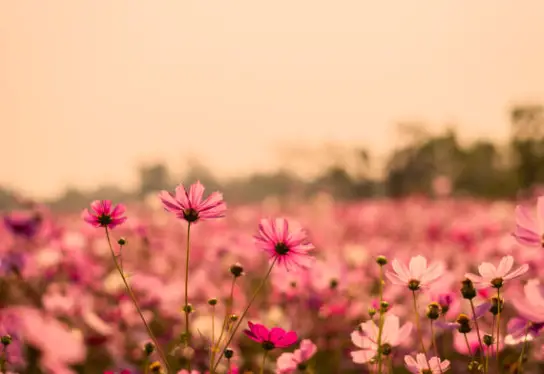
Direct sow cosmos seeds straight into the garden once temperatures stay above 60°F at night. Bury roughly 1/4 inch deep, spacing about 2 feet apart. Seedlings emerge in 7–14 days. Cosmos are not picky about soil, as long as it drains well.
They’ll need regular watering the first few weeks until established, then can get by with less supplemental watering since they are drought-tolerant perennials. For abundant bushy growth and more flowers, pinch off spent blooms periodically. Cosmos make fabulous, long-lasting cut flowers as well.
5. Calendulas
Sometimes called pot marigolds, calendulas produce vibrantly colored daisy-like flowers in shades of orange and yellow. These undemanding bloomers will flower all season until the first hard freeze.
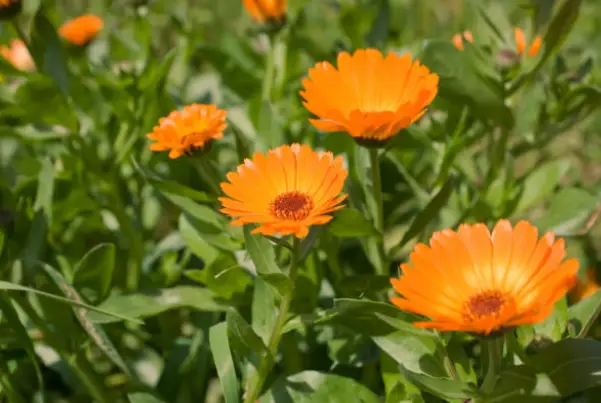
Direct sow calendula seeds about 1/2 inch deep and 12 inches apart after the last spring frost. The seeds will sprout in 5–10 days. Calendulas thrive in full sun but will tolerate partial shade. While they prefer fertile, well-draining soil, they can grow in most soil types.
Once established, calendulas require little maintenance beyond removing spent blooms to promote more flowering. They are relatively drought-tolerant but perform best with consistent moisture. Use calendula flowers to add bright pops of color to garden beds and borders. They make long-lasting cut flowers as well. The petals are edible too, with a slightly tangy flavor that can be used to garnish salads or desserts.
Top 5 Easy Perennial Flowers to Grow
While annuals provide quick pops of color, perennials are the gift that keeps on giving year after year. These are some of the easiest, low-maintenance perennial flowers that will bloom reliably with just some basic care:
1. Daylilies
As their name implies, each daylily bloom lasts just one day before withering. Don’t worry though; the plants continuously produce new flower buds for months of colorful blooms! Daylilies are incredibly hardy, reliable perennials with very few pest issues. They can grow in a wide range of soil types and light conditions, too.
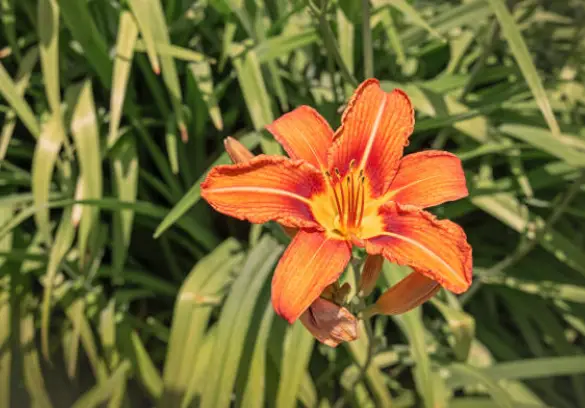
Plant daylily tubers or bare roots in early spring or fall, spacing 1-2 feet apart. Provide well-draining soil and at least 6 hours of sun per day for best blooming. Water newly planted daylilies frequently until they are established, then just provide supplemental water during dry spells. Divide overcrowded clumps every 3–4 years to maintain vigor.
While they look delicate, daylily flowers are edible and can be used to garnish salads or floated in drinks. The plants bloom continuously from late spring through fall in a rainbow of colors like yellow, orange, red, purple, and more! Daylilies make a great hassle-free flowering perennial border.
2. Coneflowers (Echinacea)
With their cheerful daisy-like petals radiating from a spiky orange seed cone, coneflowers are a classic meadow-style perennial. Their drought tolerance and ability to attract pollinators make them a top pick too.

Coneflowers (Echinacea)
Coneflowers can be grown from seed sown directly in the ground in spring, or you can plant potted nursery transplants. Space plants 2 feet apart in a full-sun location. Provide well-draining soil and water regularly for the first season until roots are established.
These sturdy, long-blooming perennials require very little maintenance once settled in. Mature coneflower clumps can get by with infrequent watering, even during hot, dry periods. Leave some coneflower seed heads on the plants at season’s end; their nutritious seeds provide food for songbirds during winter. Coneflowers bloom continuously from mid-summer into early fall.
3. Black-Eyed Susans
You can’t get much easier than black-eyed Susans! This tough native wildflower provides vibrant yellow blooms from June through September with almost no effort.
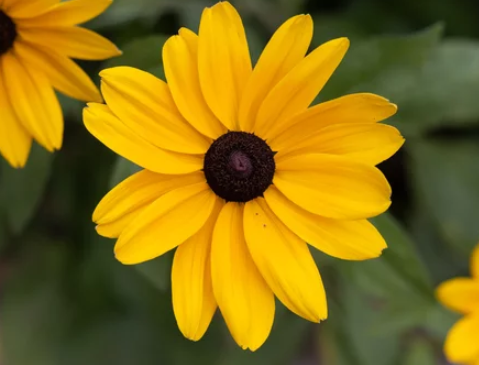
Black-Eyed Susans
Direct seed black-eyed Susans by raking the seeds into the soil in early spring, or plant nursery transplants 1-2 feet apart after danger of frost has passed. Mature plants can reach up to 3 feet tall and spread rapidly via underground rhizomes to form dense colonies.
Give black-eyed Susans a spot in full sun and well-draining soil. Though very drought-tolerant, they’ll perform best with consistent moisture through their first season. After that, they can thrive without any supplemental watering. Just leave the dead stems and seed heads standing through winter; new growth will emerge from the same roots in spring. Divide clumps every few years to control spread if desired. Black-eyed Susans are a perfect, no-fuss, native perennial!
4. Balloon Flowers
Balloon flowers earn their name from their distinct puffy buds that gradually unfurl into beautiful purple bell-shaped blooms. These whimsical perennial flowers attract butterflies and bloom continuously for months on end.
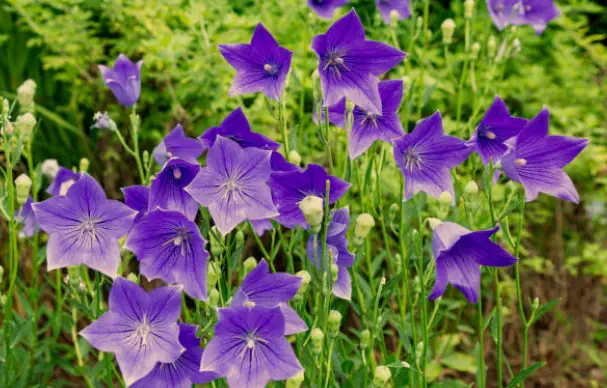
Plant balloon flower tubers or potted transplants in spring after the last frost. Space plants 12–18 inches apart in full sun to partial shade. While they’ll grow in average, well-draining soil, balloon flowers prefer fertile, humus-rich ground with consistent moisture. Provide about an inch of water weekly through blooming season for best flower production.
Once established, balloon flowers form large, dense colonies of upright plants reaching 2–3 feet tall. They’ll send up masses of striking purple flower spikes from late spring until fall’s first frosts.
5. Hostas
For reliable perennial color in shady areas, you can’t beat hostas! These attractive foliage plants produce upright spikes of lavender or white blooms in summer but are primarily grown for their lush mounds of hearty leaves.
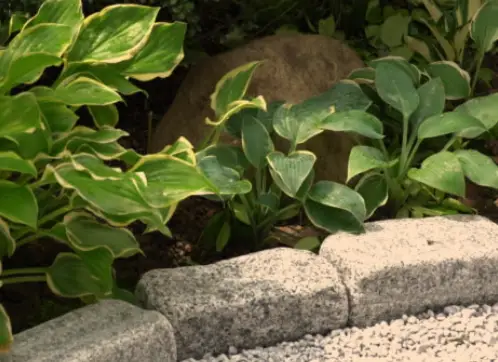
Hostas come in hundreds of varieties, with leaf colors ranging from solid green to blue, gold, white and combinations.
Hostas can be planted in spring or fall. Space them 1-3 feet apart, depending on the variety’s mature size, that can range from miniature 6-inch plants to massive 4-foot-wide clumps. Hostas thrive in moist, nutrient-rich, well-draining soil and appreciate afternoon shade. Water frequently when they are first planted to get them established.
Once settled in, hostas will return reliably year after year with bigger clumps, creating a lush ground cover. Mature plants can get by with just deep watering during dry spells. Divide overcrowded clumps every 3–4 years in spring or fall. Hostas are virtually maintenance-free, making them ideal for any shady areas. Their structural leaves and dainty summer blooms provide long-lasting color and interest.
Tips for Planting and Growing Easy Flowers
No matter which flowers you choose to grow, following some basic tips will help ensure your success:
Soil Prep
Most flowers perform best in fertile, loose, well-draining soil rich with organic matter like compost or aged manure. Take time to prepare your planting beds by digging in several inches of amendments to improve poor soils. This gives flowers the ideal foundation for establishing strong root systems.
Timing
Pay attention to the recommended planting times on seed packets or nursery tags. Some flowers like cool weather, while others need warm soil to germinate and thrive. Planting too early can lead to rotted seeds or stunted seedlings getting nipped by late-cold snaps. Sowing too late means missing out on blooms.
Spacing
While it’s tempting to crowd flowers together, they need adequate air flow and space for their roots to spread. Follow spacing guidance and account for each plant’s mature size. Cramped flowers experience more diseases, produce fewer blooms, and struggle overall.
Sun Exposure
Most flowers need at least 6–8 hours of direct sun per day for optimal growth and flowering. Observe how sunlight hits your planting areas throughout the day and choose varieties to match. Providing the right conditions from the start is key.
Watering
Newly planted flowers need consistent moisture to develop healthy root systems their first season. Aim to provide about 1 inch of water weekly, either from rain or supplemental watering. Established annual and perennial flowers can typically get by with less frequent watering, but may need extra drinks during stretches of hot, dry weather.
Deadheading
For most annual flowers, removing spent blooms (called “deadheading”) encourages lush new growth and extra flower production. With perennials, deadheading isn’t absolutely necessary for plant health, but it will neaten up the plant’s appearance and possibly trigger extra blooms before season’s end.
Winter Protection
In colder climates, provide extra insulation for perennial flowers before winter by cutting back dead plant matter and applying fresh mulch like bark chips or leaves. This protects crowns and roots from harsh temperature swings. Spring care may include removing old growth to allow new shoots to emerge easily.
With just a little bit of care when planting and maintaining them, these easy annual and perennial flowers will brighten up your yard all season long! Don’t be intimidated to try growing flowers as a beginner. Even gardening newbies can produce incredible flowerbeds and bouquets with these low-maintenance varieties.

